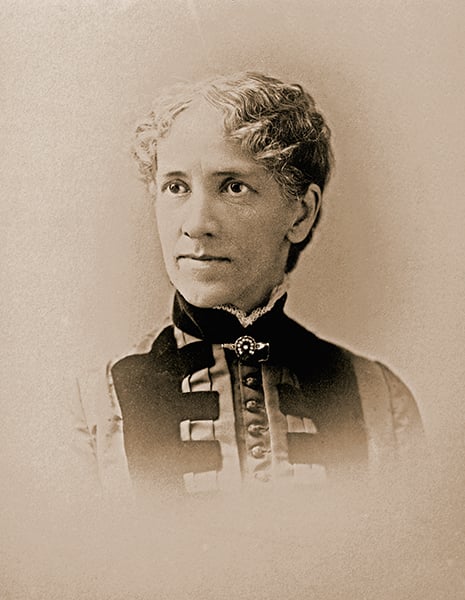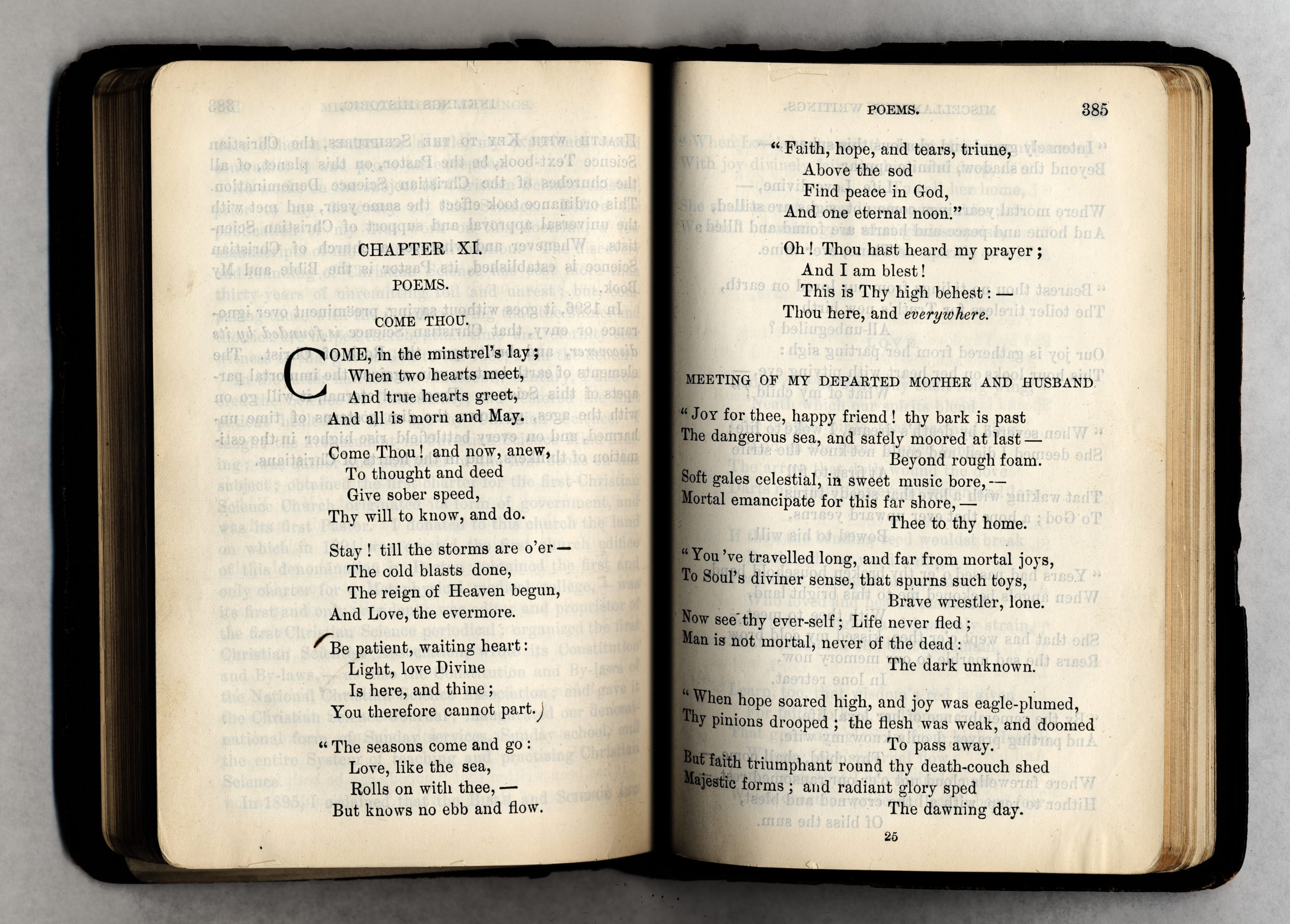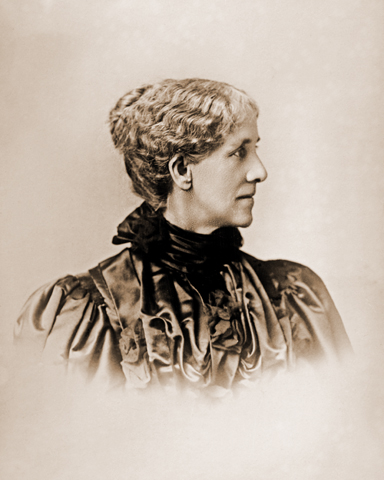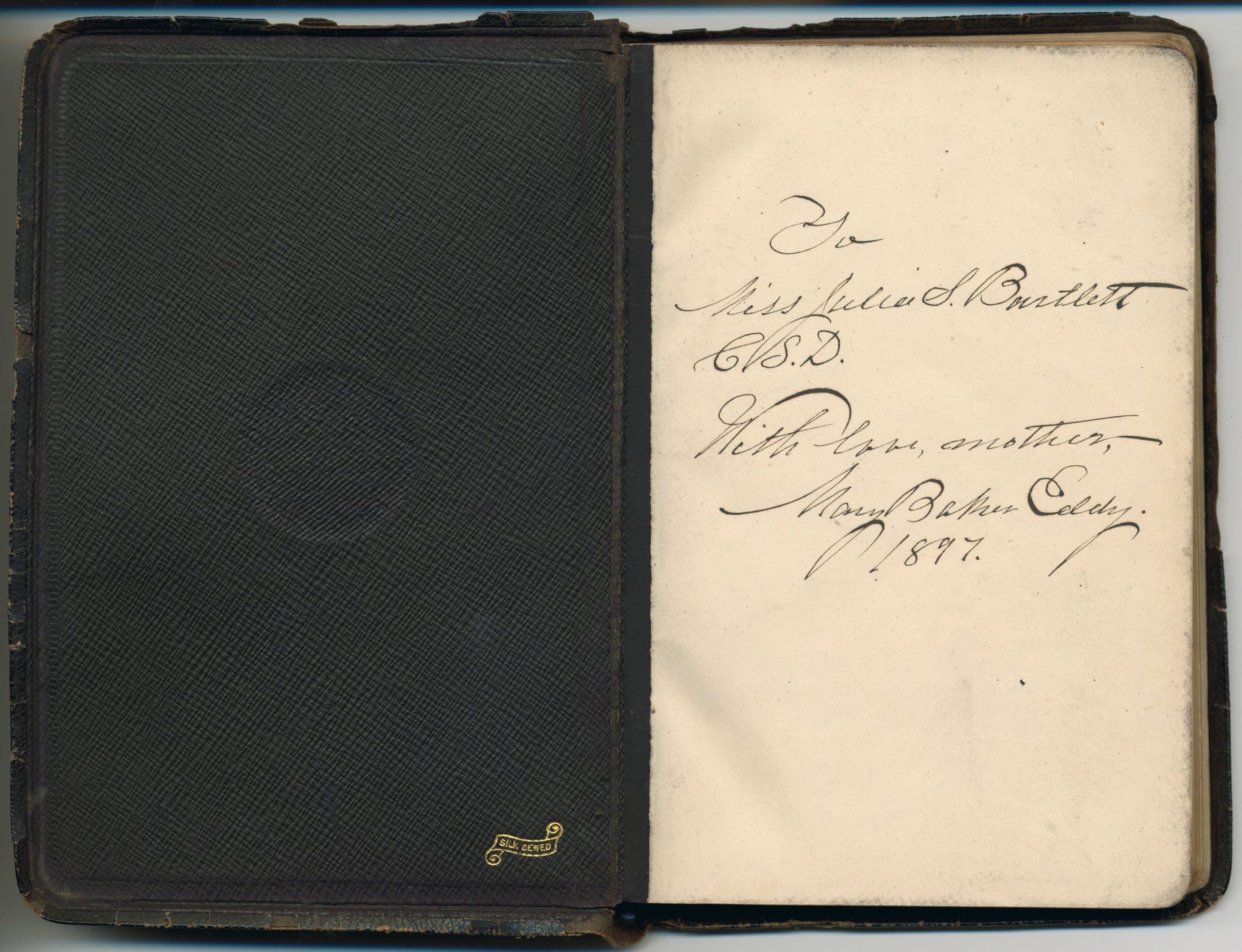
A gift of love
In 1897 Mary Baker Eddy sent Julia Bartlett a copy of Miscellaneous Writings 1883–1896 with the inscription,
“To Miss Julia S. Bartlett C. S. D.
With love, mother,
Mary Baker Eddy. 1897.”
Julia’s much loved brother had recently passed on, and to comfort her student, Mrs. Eddy had placed the ribbon marker at the poem “Come Thou” and marked the fourth verse, which begins, “Be patient, waiting heart….” Julia was deeply touched by this gesture of love from Mrs. Eddy and never removed the ribbon from that page, where it remains in the Longyear Museum collection to this day.
Other documents, such as the more than fifty letters Mrs. Eddy wrote to Miss Bartlett during their long association, indicate the high esteem in which Julia was held by her teacher and Leader. One of these letters begins, “My dear Student and ‘own child,’ ” and concludes with love from her “Affectionate Teacher and Mother.”1 In a letter to another student, Mrs. Eddy wrote that “the more [Julia] exhibits herself to me the more I love her[;] she seems to me like my child.”2

Who was Julia Bartlett?
Who was Julia Bartlett, and why was she so much beloved by the Discoverer and Founder of Christian Science?
Surely a major reason was her unflagging loyalty to Mrs. Eddy and the Cause of Christian Science. By the time she and eleven other followers had gathered in her Boston rooms in 1892 to form the corporation that would be known as The First Church of Christ, Scientist, she was, according to biographer Robert Peel, “the earliest of Mrs. Eddy’s students still to be active, loyal, and prominent in the movement” (Mary Baker Eddy: The Years of Authority, page 32).
Miss Bartlett’s devotion to Christian Science is evidenced in the many positions of responsibility she held in the early days of the Church of Christ, Scientist (founded in 1879): its President for one year, Treasurer for over five years, and one of its Directors for over six years. She was a member of the Massachusetts Metaphysical College Corporation (chartered in 1881), and a member of the first Bible Lesson Committee, appointed in January 1890. She was one of the forming members of the National Christian Scientist Association — on its Executive Committee for one term and twice its Treasurer. And when it came time to reorganize the Church to its present form (1892), she was one of the twelve First Members.3

Finding and living Christian Science
Julia Bartlett’s life in Christian Science began when she was in her late thirties. Her life up until that time had been fraught with difficulties. Born and raised in Connecticut, at age sixteen she lost her mother, and thus became a mother to her five younger siblings. As a young woman she spent quite a few years as a bedridden invalid, seeking medical help but finding no permanent relief. Yearning for comfort, she looked in vain to the conventional teachings of traditional Christianity — until a friend sent her a circular about Christian Science in 1880, when she was thirty-eight. She immediately sent for a copy of Science and Health (the rest of the title, “with Key to the Scriptures,” was added in a later edition), and, through her friend, asked its author, Mary Baker Eddy, to recommend a practitioner. Mrs. Eddy assigned her case to her husband, Gilbert Eddy, and Julia was quickly healed.4
From then on Miss Bartlett was committed to the Cause of Christian Science and devoted herself wholeheartedly to serving it for the rest of her life. In 1880 she took class instruction with Mrs. Eddy at her home in Lynn, Massachusetts.5 Soon she “launched out into the deep” (Luke 5:4) and began her own healing practice.
At first she had difficulty renting rooms from suspicious landlords in Boston, and so, with another Christian Scientist, she opened an office in nearby Charlestown.6 There she and her friend held Christian Science services, and Julia’s practice grew to as many as thirty patients a day.7
In 1882 Mrs. Eddy asked Miss Bartlett to come to Boston and live at the newly established Massachusetts Metaphysical College, where she remained for two years. While there, she served as Treasurer of the infant Church of Christ, Scientist (1879 organization), and continued to take patients and heal successfully, often using her own income to cover church expenses. At one point, though, the patients suddenly stopped coming, and she was faced with bleak poverty. She tells the story in her reminiscence:
To reduce expenses I then began to take meals out and to reduce the supply as well, and for the first time I knew what it was to suffer from hunger day after day. I did not trouble dear Mrs. Eddy or any one with the extreme conditions, so far as I could hide them. It was my problem to solve. I finally thought relief must come soon if I was to remain in the [Massachusetts Metaphysical] College, and taking my Bible for my guidance, I opened to these words: “She … shall remain in thine house.”8 It was no longer a question with me. I must and could work it out. Then one day patients began to come. The attempt to take me away and deprive Mrs. Eddy of the help she needed had failed and I had no more trouble that way, and she said I never would.9
Difficult as this episode was, it proved a milestone in Miss Bartlett’s spiritual development:
This experience which was new to me, and my dependence for relief wholly on God, was a most valuable lesson for which I have always been grateful. I remarked to Mrs. Eddy, “We are commanded to take up our cross daily, but I am not doing so, for I do not see any to take up.” Her answer was, “It is because it has ceased to be a cross.”10
News of Miss Bartlett’s success as a healer reached New Hampshire in 1884, after she healed a young woman whom physicians had been unable to cure (actually, the doctor in attendance had sent her to Miss Bartlett), and the patient, upon returning home, spread the word to her friends and neighbors up north. And so, at Mrs. Eddy’s urging, Julia journeyed one hundred and fifty-four miles to the young woman’s town of Littleton, New Hampshire, where she remained for eleven days. There she gave two talks on Christian Science to capacity audiences in a local hall, and treated as many as seventy patients a day.11 In a letter to Mrs. Eddy, she exclaimed,
There is a perfect rush of patients. Three M.D.’s are sending me patients…. I am turning away ten or a dozen patients every day that I cannot find time to see…. I am just thronged.12
Overwhelmed by the requests for healing, she telegrammed to Boston for help. As there was no one else available, Julia handled the situation through prayer, writing,
It is God that is doing this work, but when it is done I shall be so glad to go home. It is late in the night. I have no time to eat, drink, or sleep.13
Miss Bartlett maintained that her one desire was “to do the best and all I could for those dear people during my short stay with them, and God wonderfully blessed my efforts.”14 As a result of her work in Littleton, many of those she healed later became practitioners and teachers of Christian Science, and prominent workers in the movement.15
In addition to her practice, Julia Bartlett was a teacher of Christian Science for almost forty years, from 1884 to 1922. She taught primarily in Boston, but between 1886 and 1889 she taught classes also in Littleton, New Hampshire; several places in Vermont; Atlanta, Georgia; Calais, Maine; Fredericton and St. John, New Brunswick; Halifax, Nova Scotia; and Logansport, Indiana.16
Relationship with Mrs. Eddy

Miss Bartlett enjoyed a close and tender relationship with Mrs. Eddy, who often invited her student to visit her at Pleasant View. Julia treasured her memories of “the hours spent with her when the cares of the day were laid aside as much as possible and we were free to talk of the things we loved to speak of. She was so lovingly thoughtful for my comfort and happiness, and all her conversation was so dear, uplifting, and helpful, it was a joy to be with her.17
The great Leader of Christian Science appreciated Miss Bartlett’s thoughtfulness and sensitivity to her needs. Mrs. Eddy “was always mindful of the little things,” Julia wrote. “No kind act or loving thought escaped her notice and appreciation; such things only helped to brighten her pathway…. I always felt how little I was doing for her who was doing so much for me and for all mankind.”
As a faithful follower of Mrs. Eddy and Christian Science, Julia, too, did much “for all mankind.”18